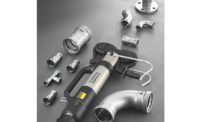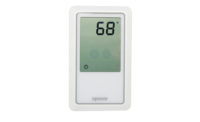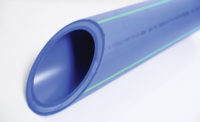After walking the 2016 AHR Expo in January in Orlando, Fla., it is clear plumbing and HVAC consulting-specifying engineers, contractors and building owners have more choices than ever when selecting materials and standards for pipe, valves and fittings for domestic-water system applications.
PVF manufacturers from around the globe have been aggressively pursuing the North American market due to the more stabilized economy and optimistic building forecast as compared with the European or Asian markets. However, many of these new products have yet to be proven in the field by withstanding the operating conditions of a commercial domestic-water piping system.
Over the past decade, PEX — an acronym for crosslinked polyethylene — has become the most-installed plumbing pipe for new (and re-piping) residential applications compared with copper and CPVC combined. So it’s no surprise PEX is now expanding into the commercial market as well. With 25 years of successful operation in potable-water systems, PEX has proven itself a major player in the residential marketplace. Meanwhile, the commercial sector is beginning to understand the benefits of this flexible, durable piping product.
PEX piping systems use either insert fittings or expansion fittings to create connections.
- Insert fittings are listed to ASTM F1807 (Standard Specification for Metal Insert Fittings Utilizing a Copper Crimp Ring for SDR9 Cross-linked Polyethylene (PEX) Tubing) and ASTM F2159 (Standard Specification for Plastic Insert Fittings Utilizing a Copper Crimp Ring for SDR9 Cross-linked Polyethylene (PEX) Tubing).
- Expansion fittings are listed to ASTM F1960 (Standard Specification for Cold Expansion Fittings with PEX Reinforcing Rings for Use with Cross-linked Polyethylene (PEX) Tubing).
Until recently, PEX pipe, valves and fittings were limited to 1/2-in. through 2-in. sizes. However, with the continued expansion of larger-dimension product offerings and increased code approvals and listings for use in commercial plumbing and hydronic piping applications, PEX is strengthening its market share. Much like it did in the residential sector, PEX again has the potential to become the dominant player in the world of commercial plumbing and hydronic piping systems.
Today, PEX pipe — specifically ASTM F1960 fittings — is being offered in the larger sizes of 2 1/2 in. and 3 in., allowing greater use and flow in commercial plumbing and hydronic piping applications. This newly expanded PEX pipe and ASTM F1960 fittings offering allows designers and specifiers to select a PEX system, rather than copper, CPVC or other traditional materials used in commercial piping systems.
PEX pipe is manufactured to be a copper tube size (CTS) pipe with a wall thickness conforming to a standard dimension ratio of 9 (SDR9). In addition, the pipe is approved by all model plumbing codes for domestic water-piping applications according to ASTM F876 and F877 standards.
Three types of PEX
PEX-a: The Engel method, also called PEX-a, is named after German inventor Dr. Thomas Engel. This method crosslinks the polyethylene molecules during the extrusion process when polyethylene is in its amorphic state (above the crystalline melting point). This method also is referred to as a “hot” crosslinking process.
With the PEX-a method, crosslinking reaches about 85%, the highest degree of all PEX types. This level of crosslinking creates the greatest flexibility as well as thermal and elastic memory. The latter characteristic means kinks in the pipe can be repaired with the use of a heat gun, and pipe can be expanded to accept a high-flow ASTM F1960 “cold-expansion” fitting.
PEX-b: The Silane method, also called PEX-b, crosslinks the tubing after the extrusion process by placing the pipe in a hot water bath or steam sauna. The degree of crosslinking for PEX-b is typically around 65 to 70%. Because PEX-b is not as evenly crosslinked as PEX-a pipe, it does not have the same degree of flexibility or thermal memory (hence, no kink reparability).
PEX-c: The E-beam method, also called PEX-c, uses an electron beam to change the molecular structure of the tubing (i.e., crosslinks) after the extrusion process. The PEX-c method requires multiple passes under the beam to reach a 70 to 75% degree of crosslinking. Side effects of this process are discoloration due to oxidation (from natural white to yellow, unless other pigment is added), and a slightly stiffer product.
Key characteristics and considerations
PEX hydrostatic temperature and pressure ratings: PEX pipe meets the following temperature and pressure ratings:
- 200° F at 80 psi;
- 180° at 100 psi; and
- 73.4° at 160 psi.
In accordance with ASTM F876, the minimum hydrostatic burst pressure for PEX pipe is 480 psi (for 1/2-in. pipe) and 475 psi (for 3/4-in. pipe and larger) at 73.4°.
Thermal conductivity: PEX pipe does not sweat like copper due to its very low coefficient of thermal conductivity of 0.219 Btu/(hr•ft²•°F). Copper has a coefficient of thermal conductivity between 300 and 400 Btu/(hr•ft²•°F), depending on wall thickness (Type K, L or M).
The thicker walls of PEX pipe act as an insulator, offering insulation values of about R-0.19. The heat transfer from copper is much greater; PEX offers up to 30% better insulating value when comparing uninsulated PEX to uninsulated copper pipe.
Surge pressure and sound intensity: Typical polymers will absorb sound in the range of 10 dB/cm; metals, on the other hand, absorb sound only in the range of 0.1-1.0 dB/cm. For a given change in velocity, the intensity of sound from a copper pipe will be at least eight times higher than that of PEX-a pipe. Furthermore, using PEX instead of copper can reduce peak pressures caused by a quick-acting valve by 18 to 40%.
Freeze resistance: Due to its flexibility and expansion characteristics, PEX pipe is much more freeze-resistant when compared with copper and CPVC. Because of its thermal and shape memory, PEX-a pipe, in particular, can expand up to three times its extruded diameter. Consequently, if water freezes in the pipe, the pipe can flex to accommodate the expansion and then shrink back down after the ice thaws.
Chlorine resistance: All PEX manufacturers are required to test their pipe’s resistance to hot, chlorinated water and list the PEX designation on the pipe’s print stream. Some PEX manufacturers meet the highest requirement for chlorine resistance at end-use conditions 100% of the time at 140°. Consult with individual PEX manufacturers to verify whether their PEX designations meet the intended application.
Suspended piping: PEX can be supported by the same CTS pipe hangers or supports used for metallic pipe. The horizontal support spacing for 1 in. and smaller PEX is 32 in.; for 1 1/4 in. and larger pipe diameters, 48 in. (Note: Some codes allow for only 32-in. horizontal support spacing regardless of pipe size, so be sure to check local codes for verification.)
For suspended applications requiring more or less restrictive support spacing, engineers can specify products offering continuous support, helping to lower labor and material costs. One such product is an extruded, galvanized, half-round CTS channel that snaps onto the PEX pipe, offering greater support spacing of 8 ft., and the ability to field-insulate around the piping and channel.
Risers: PEX risers require a CTS riser clamp at the base of each floor. The installation also should include a riser clamp at the top of every other story to limit the expansion and contraction to pipe lengths less than 25 ft. This translates to an expansion of about 1 1/2 in. in 25 ft. at a 60° Delta T (installed at 60° with an operating temperature of 120°). In this application, the piping will snake slightly in areas where it is not constrained, requiring the use of mid-story guides.
Fire-resistant construction: PEX manufacturers are required to test their products and assemblies to multiple ASTM fire-resistant standards if such products are to be installed in fire-rated applications. Some PEX manufacturers have been approved for installation in applications requiring plenum-rated pipe as well as up to three-hour fire-resistive ratings.
Most firestop manufacturers offer multiple “listed” solutions for through-penetrant applications using PEX pipe. Consult with the PEX manufacturer to verify that its specific fire-resistive construction ratings and listings match the intended application.
Direct burial: PEX pipe is approved for direct burial in soil or concrete, as are certain PEX fittings and fitting materials. Check with the manufacturer for approved applications and installation guidelines. Some manufacturers also offer pre-sleeved pipe for direct-burial applications. This corrugated sleeving provides added protection for installations in concrete slabs or soil. Also, having the PEX inside the sleeve allows for quick and easy removal and replacement of the PEX pipe, if necessary, without having to break up the slab or soil.
As new PVF products are introduced into the North American market, it is reassuring to know proven PEX systems with ASTM F1960 fittings are expanding their offerings, allowing industry professionals the opportunity to select a system type that has demonstrated reliability and performance.
This article was originally titled “Going bigger” in the April 2016 print edition of PM Engineer.





